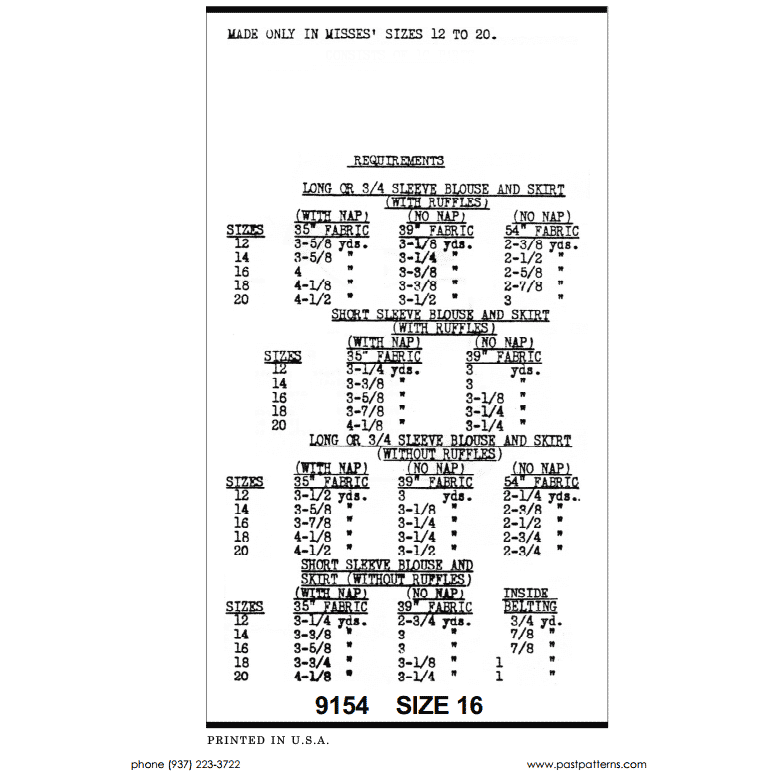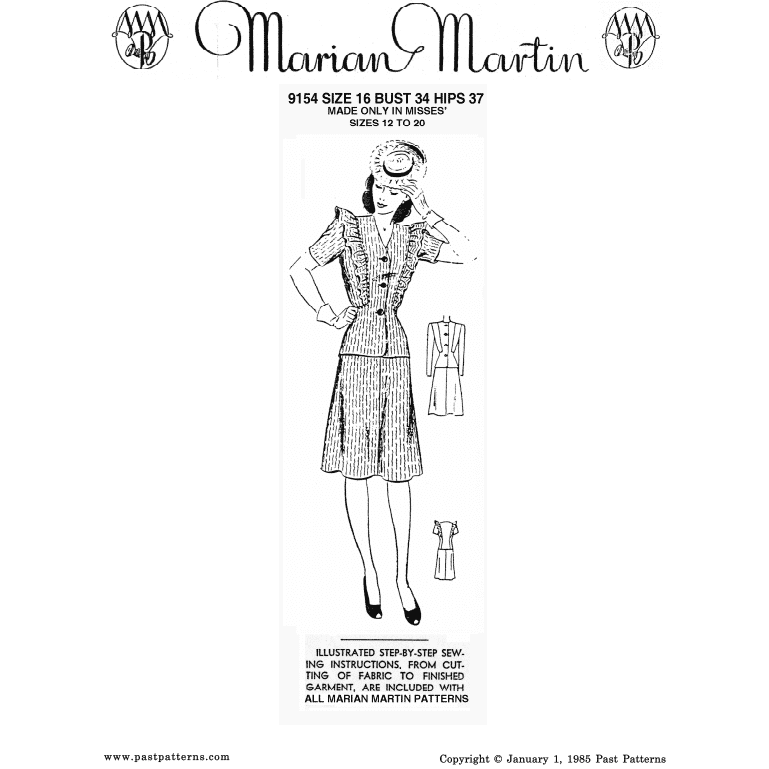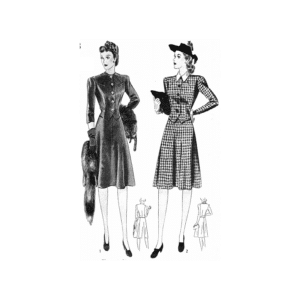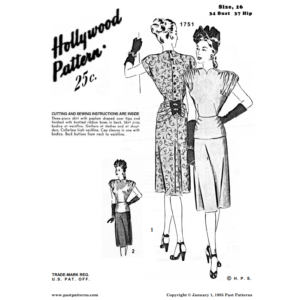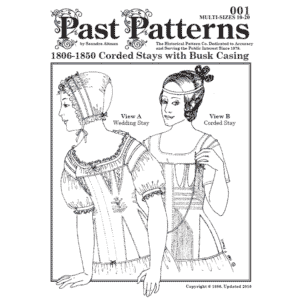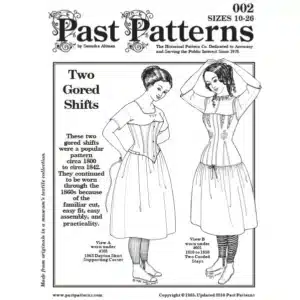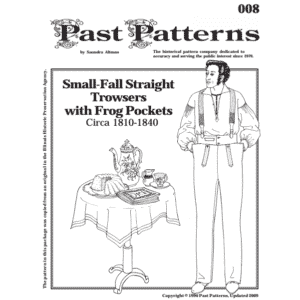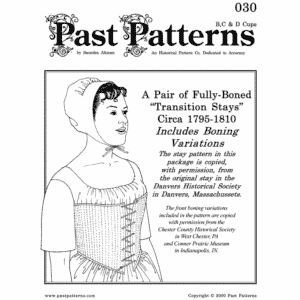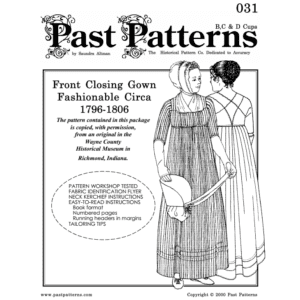Early 1940s Two-Piece Dress with Ruffles Sewing Pattern | Past Patterns 9154
$22.00
Recreate authentic 1940s style with this Early 1940s Two-Piece Dress with Ruffles Sewing Pattern (Past Patterns 9154). Originally published by Marian Martin, this versatile set includes a blouse with peplum, shoulder ruffles, and sleeve variations, paired with a knee-length skirt. Sized for a 34″ bust and 37″ hips, with detailed illustrated instructions and our Guide to Editing for fit adjustments. Printed on durable 36″ wide paper.
999 in stock
Get Free Shipping
On all US Orders over $50!
$22.00
Recreate authentic 1940s style with this Early 1940s Two-Piece Dress with Ruffles Sewing Pattern (Past Patterns 9154). Originally published by Marian Martin, this versatile set includes a blouse with peplum, shoulder ruffles, and sleeve variations, paired with a knee-length skirt. Sized for a 34″ bust and 37″ hips, with detailed illustrated instructions and our Guide to Editing for fit adjustments. Printed on durable 36″ wide paper.
999 in stock
Get Free Shipping
On all US Orders over $50!
All of our patterns tell a story.
Why Choose This Pattern?
Early 1940s Two-Piece Dress with Ruffles Sewing Pattern | Past Patterns 9154.
This Early 1940s Two-Piece Dress with Ruffles Sewing Pattern was originally published by Marian Martin and is faithfully reproduced by Past Patterns for today’s sewists.
About the Early 1940s Two-Piece Dress with Ruffles Sewing Pattern
Create up to four distinct looks from one set:
- Blouse: three-button front closure with a graceful peplum.
- Signature ruffles: begin at the natural waist, travel over the shoulders, and anchor mid-back.
- Skirt: classic two-piece skirt hemmed to the knee.
- Sleeves: choose long, ¾-length, or short sleeves.
The set contains 10 pattern pieces and features detailed, illustrated directions for confident results. This Past Patterns edition also includes our Guide to Editing for size adjustments by bust shape.
What’s Included
- Full-size printed pattern on 36" wide paper (no split pieces) — ideal for precise cutting.
- Front and back envelope artwork reproductions with a pattern-piece breakdown and yardage charts for each variation.
- 10-page instruction booklet with step-by-step written guidance and illustrations.
- Past Patterns Guide to Editing to assist with personalized fit refinements.
- All components packaged in a reusable protective sleeve and printed on durable 20 lb. white paper.
Sizing & Fit
- Original draft size: Bust 34" (86 cm), Hips 37" (94 cm). This is the only size we offer for this edition.
- Seam allowances: ½" included throughout. Use the exact allowance for accurate fit.
For adjustments, rely on the included Guide to Editing to tailor this Early 1940s Two-Piece Dress with Ruffles Sewing Pattern to your measurements while preserving period lines.
Materials & Period-Correct Colors
- Fabric: 3⅝ yards of 36" wide material.
- Authentic cloth options: rayon crepe, alpaca-type crepe, French-type crepe, macomba cloth, or novelty wool.
- Era-true colorways: navy, emerald green, luggage brown, forest green, sunset red, pecan beige, and Copenhagen blue.
Historical Context
Two-piece ensembles were a smart, flexible staple of early 1940s wardrobes, balancing elegance with utility during wartime. Women mixed blouses and skirts, favored practical details like belts and buttons, and adapted sleeve lengths to season and occasion. For a concise overview of 1940s fashion influences, explore the FIT Fashion History Timeline (1940–1949) and the Imperial War Museums’ background on clothes rationing in WWII.
Designer Marian Martin popularized accessible, mail-order patterns through newspapers and magazines across North America, celebrated for clear instructions that welcomed beginners while satisfying experienced home dressmakers.
Difficulty & Skill Level
3/5 – Intermediate. Best for sewists comfortable with structured blouses, ruffle handling, dart shaping, and assembling coordinated separates.
- Why 3/5? Ten pieces, ruffle placement over shoulders, optional sleeve variants, and peplum shaping add moderate complexity—balanced by highly illustrated instructions and a straightforward skirt.
Printed vs. Download
This page is for the printed pattern. Prefer a PDF? Get the digital version with tiled A4/8.5"×11" and full-sheet A0 options here: Early 1940s Two-Piece Dress with Ruffles Downloads.
Why You’ll Love It
The Early 1940s Two-Piece Dress with Ruffles Sewing Pattern delivers period-authentic lines, day-to-evening versatility, and a feminine shoulder treatment that flatters without fuss. Whether for reenactment, stage, film, or vintage-inspired everyday wear, this Early 1940s Two-Piece Dress with Ruffles Sewing Pattern is a reliable, stylish choice.
Wrap-Up
Create a timeless look with this Early 1940s Two-Piece Dress with Ruffles Sewing Pattern—an elegant, mix-and-match ensemble that captures the practical romance of the era.
Past Patterns 9154 — Printed Edition.
Original Content by Past Patterns. Copyright Past Patterns 1979–2025. All rights reserved.
Additional information
| Weight | 7 oz |
|---|---|
| Dimensions | 13 × 10 × 2 in |
Sizing Information
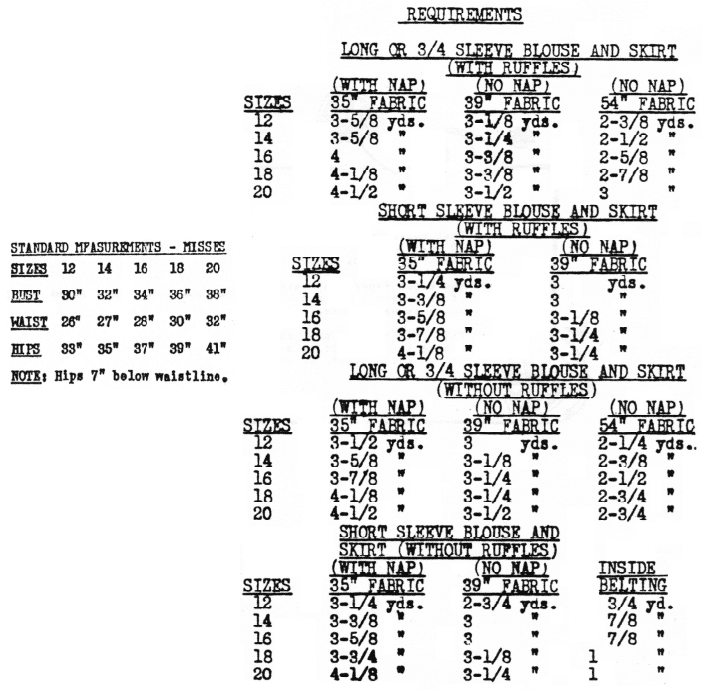
(Metric size sheet opens as a PDF in a new browser tab)
Preferred Vendors
Past Patterns works with vendors from all over the world to help us replicate the amazing articles of clothing. Now you can too!
Visit our preferred vendors page to order directly from some of our top recommended suppliers.
FAQ's
(Frequently asked questions)
Why are both Trowsers and Trousers listed on site?
Over the last 200 years, much like the human body, our style of language has changed. For vintage patterns, we attempt to use the language of the day where possible.
Can you grade (edit) a Vintage Revival pattern for my size?
please contact us with the specific pattern number and the specifications you require. We have staff available for this for an additional fee.
What sizes do Past Patterns patterns come in?
Our patterns, with some exceptions, are manufactured in sizes 8 through 26 for women and sizes 34 through 54 for men. Most patterns are multi-sized. For a complete listing of measurements in inches see the size chart.
Do you have vintage patterns (manufactured prior to 1950) that you want to sell?
we are always on the lookout for original, American designed, vintage patterns especially for categories outside of current items. We are interested if you have 1 pattern or 1000 patterns. Give us a call to discuss.
Why is my pattern size different from my off the rack dress size?
We use the U. S. Board of Standard Measurements to size our patterns. The ready made clothing manufacturers have their own set of sizes developed from their own statistics. For a complete listing of measurements in inches see the size chart.
How are the patterns packaged?
We package our patterns in two forms: Bond Paper and Tissue. Except for the Tissue patterns, each is slipped into a reusable plastic sleeve. Many contain documentation in the form of Historical Notes or the printer ie., Butterick. Because the patterns are printed in house to order, they can take from three to seven days. Tissue patterns, which are printed out of house, are available to ship immediately.
What does a Corset Kit contain in addition to the Corset pattern?
In addition to the pattern, the kits contain everything you need to make the corset except the thread. The kits contain, according to their type, fabric and lining, stays, clasp or busk board, back lacing, tape for finishing the edges, trim lace, ribbon, leather, tin stock, waist tape, punch and setter, eyelets, marking pencils, cording, reed and a loop turner.
Need a pattern in your language?
we can translate our instructions into just about any language
Have an old and incomplete Past Patterns item. What can I do?
The answer depends on if the pattern is still in production or not. If it is, please mail us the old pattern and we will ship you a copy of the latest pattern for a minimal fee along with normal shipping charges. If the item is no longer in production, we would need to know exactly what you have to determine the best course of action to help you.
What is the difference between a Past Patterns original pattern and a Vintage Revival pattern?
The Past Patterns originals were designed in house and based upon the research, disassembly and time of Saundra Ros Altman. These designs come from finds all over the United States reaching from San Diego, California to the Smithsonian Museum in Washington, DC. She created the initial patterns, the sizing charts and the instruction content. Many of the these patterns are multi-sized or are available in various sizes. For the most part, these designs are done taking into account the modern human body's shape, height and weight. The Vintage Revival patterns are traces or copies of an old, mass produced pattern; the first mass produced patterns came out in the 1850s. For the most part, you get exactly what came in the original package; in some cases, Saundra has appended historical notes to the instructions. The Vintage Revivals patterns, being copies of the originals, generally only come in one size and are based upon the size and shape of the human body from the era the pattern came from.
What software do you use to create patterns?
We utilize PW Studio for our designs. Isabelle Lott, a contributor over the years to Past Patterns, is the owner of the company and will be happy to answer an software related questions you have. Her software is available for licensing.
What measurements do I need to know to order a Corset Kit?
The bust and back length. The back length is measured from the prominent bone at the base of the neck to the natural waistline.
Where can I see the appropriate clothing fabrics for the 18th and 19th centuries?
You can see 1740 through 1940 fabrics in a book titled "Textile Designs" by Susan Meller and Joost Elffers. The subtitle states, "Two Hundred Years of European and American Patterns for Printed Fabric by Motif, Style, Color, Layout and Period and 1,823 Illustration in Color." What they don't say is that 90% of the swatches pictured are life size. The ISBN is 0-8109-3853-7. A second book is Wearable Prints, 1740-1860, History, Materials, and Mechanics by Susan W. Greene. The ISBN is 978-1-60635-124-6. Great books! Order it from your local library that has interlibrary loan capability if you cannot afford the price. There are now many sources for appropriate fabric through the Internet.
Where can I find antique patterns to purchase?
On the Internet try: "Patterns from the Past."
Need a pattern tomorrow?
we do offer expedited domestic shipping for extra fees. We can also expeditie international shipments but delivery dates overseas cannot be promised.
Becoming a Wholesalers of our patterns
We offer Wholesalers significant discounts that will allow both your and our businesses to flourish.
Why don't we sell PDFs of our patterns - First due to piracy. We have spent over 40 years creating and tracing these patterns along with researching them. We print and ship all of our patterns ourselves. If we started sending out PDFs, in no time, copies of our Intellectual Property would be all over the internet and we would be out of business. Second, some of our patterns are constantly being updated. We want our clients to get the BEST POSSIBLE version of our products.


